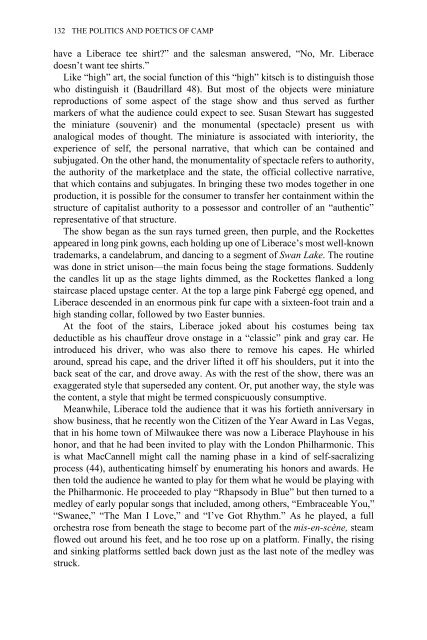Edited by Moe Meyer - Get a Free Blog
Edited by Moe Meyer - Get a Free Blog
Edited by Moe Meyer - Get a Free Blog
Create successful ePaper yourself
Turn your PDF publications into a flip-book with our unique Google optimized e-Paper software.
132 THE POLITICS AND POETICS OF CAMP<br />
have a Liberace tee shirt?” and the salesman answered, “No, Mr. Liberace<br />
doesn’t want tee shirts.”<br />
Like “high” art, the social function of this “high” kitsch is to distinguish those<br />
who distinguish it (Baudrillard 48). But most of the objects were miniature<br />
reproductions of some aspect of the stage show and thus served as further<br />
markers of what the audience could expect to see. Susan Stewart has suggested<br />
the miniature (souvenir) and the monumental (spectacle) present us with<br />
analogical modes of thought. The miniature is associated with interiority, the<br />
experience of self, the personal narrative, that which can be contained and<br />
subjugated. On the other hand, the monumentality of spectacle refers to authority,<br />
the authority of the marketplace and the state, the official collective narrative,<br />
that which contains and subjugates. In bringing these two modes together in one<br />
production, it is possible for the consumer to transfer her containment within the<br />
structure of capitalist authority to a possessor and controller of an “authentic”<br />
representative of that structure.<br />
The show began as the sun rays turned green, then purple, and the Rockettes<br />
appeared in long pink gowns, each holding up one of Liberace’s most well-known<br />
trademarks, a candelabrum, and dancing to a segment of Swan Lake. The routine<br />
was done in strict unison—the main focus being the stage formations. Suddenly<br />
the candles lit up as the stage lights dimmed, as the Rockettes flanked a long<br />
staircase placed upstage center. At the top a large pink Fabergé egg opened, and<br />
Liberace descended in an enormous pink fur cape with a sixteen-foot train and a<br />
high standing collar, followed <strong>by</strong> two Easter bunnies.<br />
At the foot of the stairs, Liberace joked about his costumes being tax<br />
deductible as his chauffeur drove onstage in a “classic” pink and gray car. He<br />
introduced his driver, who was also there to remove his capes. He whirled<br />
around, spread his cape, and the driver lifted it off his shoulders, put it into the<br />
back seat of the car, and drove away. As with the rest of the show, there was an<br />
exaggerated style that superseded any content. Or, put another way, the style was<br />
the content, a style that might be termed conspicuously consumptive.<br />
Meanwhile, Liberace told the audience that it was his fortieth anniversary in<br />
show business, that he recently won the Citizen of the Year Award in Las Vegas,<br />
that in his home town of Milwaukee there was now a Liberace Playhouse in his<br />
honor, and that he had been invited to play with the London Philharmonic. This<br />
is what MacCannell might call the naming phase in a kind of self-sacralizing<br />
process (44), authenticating himself <strong>by</strong> enumerating his honors and awards. He<br />
then told the audience he wanted to play for them what he would be playing with<br />
the Philharmonic. He proceeded to play “Rhapsody in Blue” but then turned to a<br />
medley of early popular songs that included, among others, “Embraceable You,”<br />
“Swanee,” “The Man I Love,” and “I’ve Got Rhythm.” As he played, a full<br />
orchestra rose from beneath the stage to become part of the mis-en-scène, steam<br />
flowed out around his feet, and he too rose up on a platform. Finally, the rising<br />
and sinking platforms settled back down just as the last note of the medley was<br />
struck.


